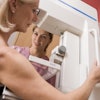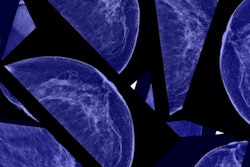
High breast compression force and low compression pressure are associated with positive performance measures such as lower recall rate and higher specificity, a Norwegian breast cancer screening study has found.
 Dr. Nataliia Moshina, a doctoral research fellow at the Cancer Registry of Norway in Oslo.
Dr. Nataliia Moshina, a doctoral research fellow at the Cancer Registry of Norway in Oslo.Researchers categorized compression force and pressure of more than 261,000 mammography exams to determine performance measures such as recall rate, sensitivity, specificity, and positive predictive value (PPV). They found higher is better when comparing compression forces. Conversely, lower is better when examining compression pressure.
"Based on our findings, low compression pressure and high breast volume are associated with favorable early performance measures, including lower recall rate, higher rate of screen-detected cancer, and lower rate of interval breast cancer, compared with high compression pressure and low breast volume," wrote the study authors, led by Dr. Nataliia Moshina, a doctoral research fellow at the Cancer Registry of Norway in Oslo (Breast Cancer Research and Treatment, 29 March 2017).
High vs. low
The radiologic detection of breast cancer depends on image quality, which has been claimed to be associated with breast compression. As of today, there are no evidence-based guidelines providing optimal values of compression force for screening or diagnostic mammography, according to the study authors.
A new approach based on pressure standardization has recently been suggested in the literature, primarily to aid in pain reduction. Any implementation of standardized breast compression with the goal of pain reduction should be based on the evidence regarding the harms and benefits of limited compression force and pressure, they noted, which is currently lacking -- until now.
Moshina and colleagues used data collected from 93,444 women as a part of the Norwegian Breast Cancer Screening Program to explore early performance measures stratified by compression force and pressure.
Compression forces and pressure were categorized using tertiles as low, medium, or high, as noted in the table below.
| Comparison of compression force and pressure | ||||||
| Compression force | Compression pressure | |||||
| Low (≤ 117.5 N) |
Medium (117.5-129.9 N) |
High (≥ 130 N) |
Low (< 9.8 kPA) |
Medium (9.8-13 kPA) |
High (> 13.1 kPa) |
|
| Recall rate due to abnormal findings | 2.5% | 2.3% | 2.2% | 2.2% | 2.3% | 2.5% |
| Rate of SDC (per 1,000 exams) |
5.44 | 5.59 | 5.90 | 6.08 | 5.67 | 5.12 |
| PPV | 22.1% | 24.0% | 26.4% | 27.6% | 24.2% | 20.5% |
| IC rate (per 1,000 exams) | 1.82 | 1.67 | 1.61 | 1.61 | 1.57 | 1.99 |
| Sensitivity | 74.8% | 76.9% | 78.7% | 78.5% | 78.2% | 72.6% |
| Specificity | 98.1% | 98.3% | 98.4% | 98.4% | 98.2% | 98.0% |
"The association of high compression force and superior early performance measures might be due to reduced compressed breast thickness," the authors wrote. That's because this leads to a more solid fixation of the breast and a decreased amount of overlapping tissue. Also, the higher interval cancer rate observed for high compression pressure might be associated with tumor cell dissemination due to excessive compression above the possible tumor area, they added.
Favorable performance measures are associated with image quality, so Moshina and colleagues' results may also suggest that high compression force and low compression pressure are associated with better image quality.
The study findings suggest the standardization of compression pressure could be an alternative directed to both relieving pain and optimizing early performance measures, they added. However, the authors are cautious about their findings, noting that it is unclear if their results could be reproduced in other studies and whether recommendations on optimal values of compression force or pressure should be made.
"We think it is important to examine all sides of standardization of breast compression, including image quality and radiologists' assessment of image quality (in particular in screening mammography)," Moshina wrote in an email to AuntMinnieEurope.com.
They are planning another study that will take into account the association between compression force/pressure used during mammography and image quality as assessed by the radiologists of the screening program in Norway.
"Such a study may give us an answer on possible changes in image quality due to various compression force and pressure," Moshina wrote.



















